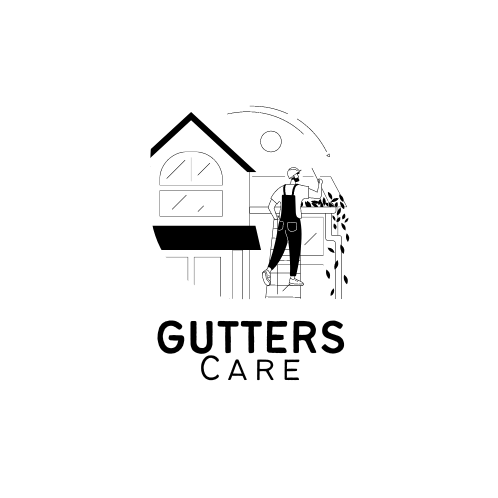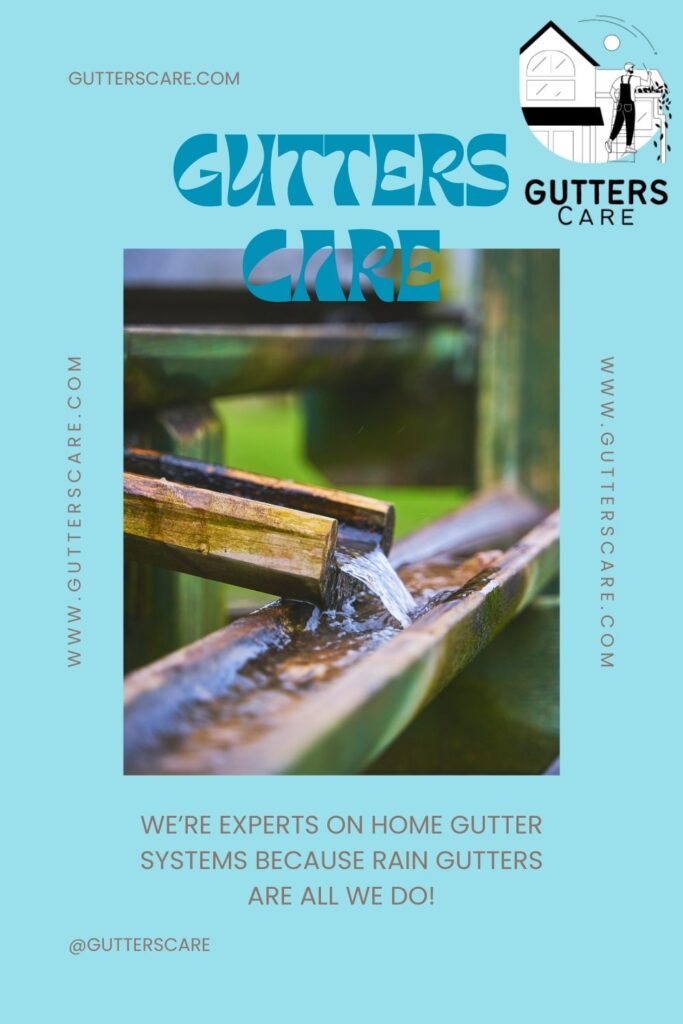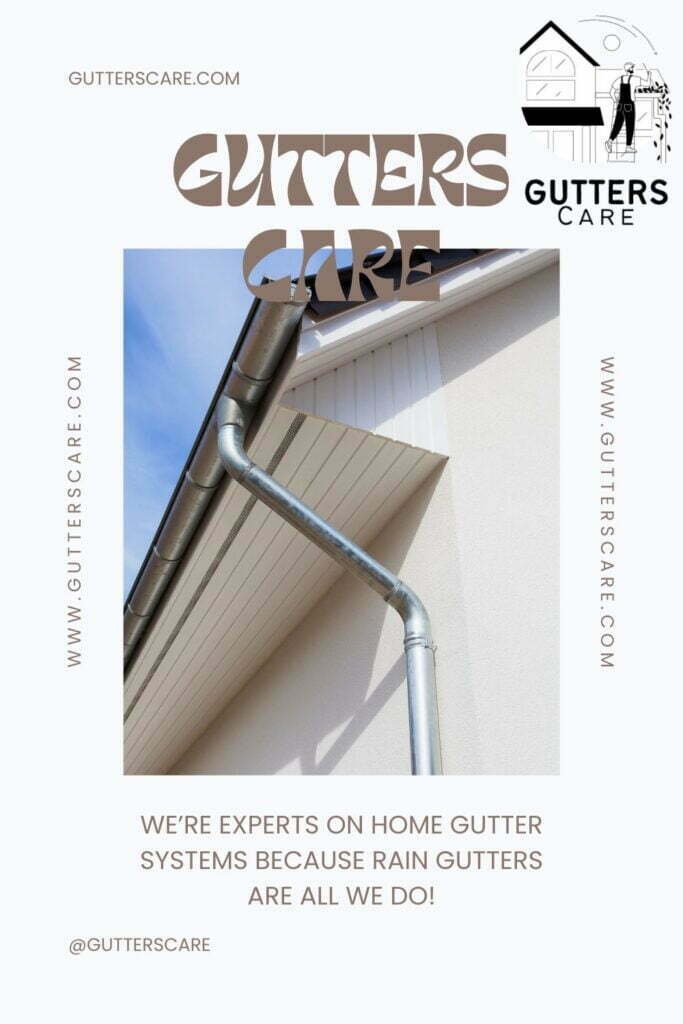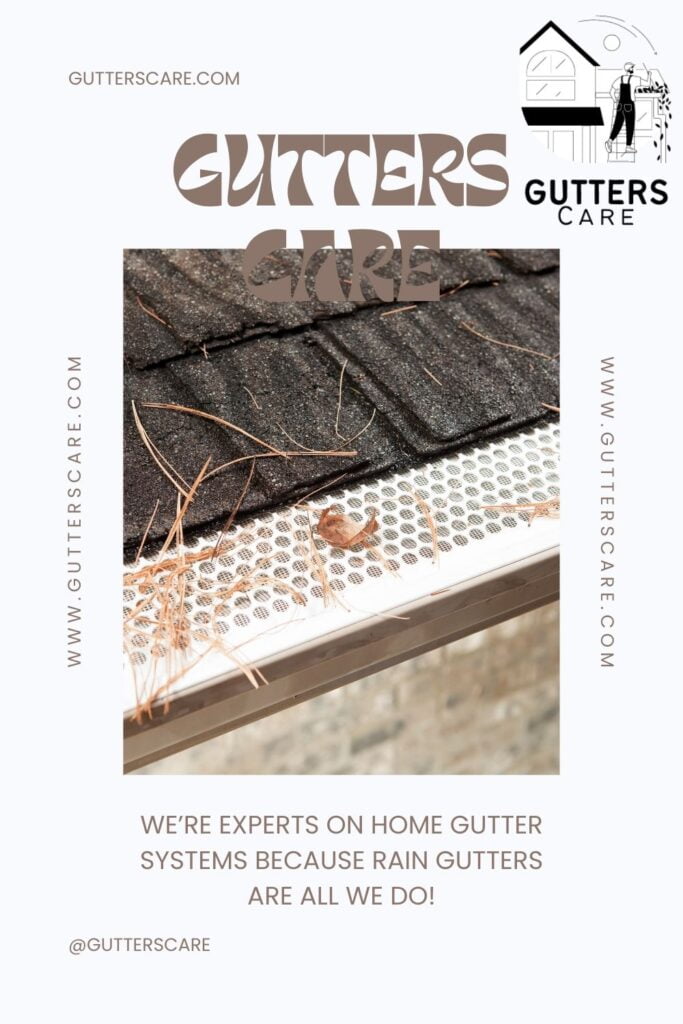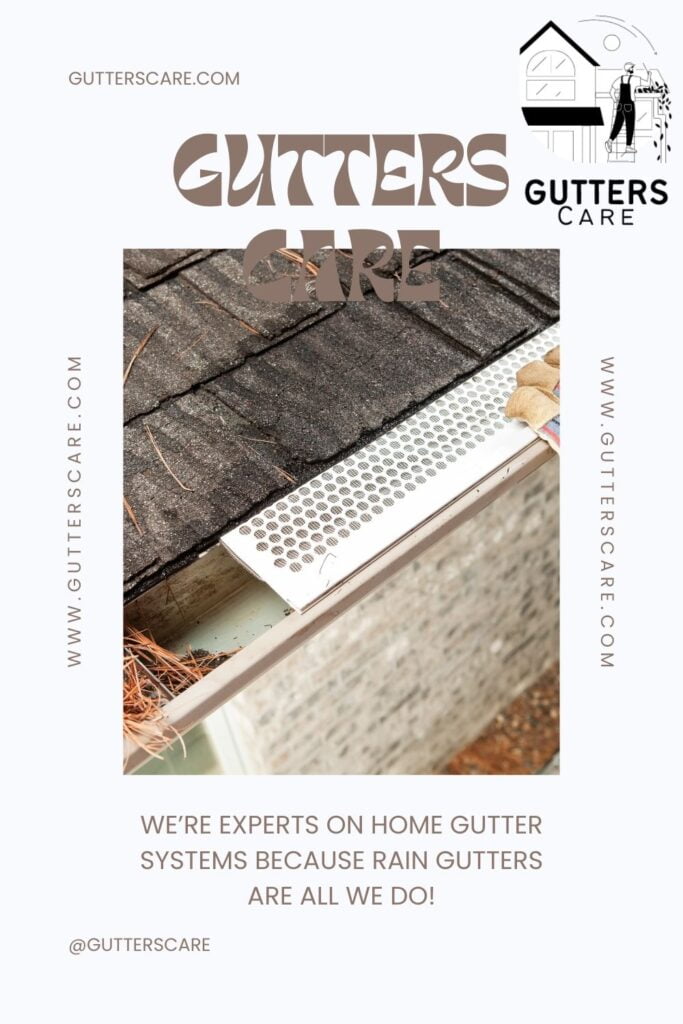Top DIY Gutter Installation Mistakes to Avoid + INFOGRAPHIC (2025)
Do-It-Yourself Gutter Installation Mistakes to Avoid
Because the process of installing gutters is significantly more complicated than it initially appears to be, it is strongly recommended that you do not undertake this task on your own but instead seek the assistance of an experienced professional.
If you choose to do the work yourself, you might be able to save some money in the beginning, but if you make any mistakes, your property might sustain serious water damage, which will wind up costing you more money in the long run.
- Do-It-Yourself Gutter Installation Mistakes to Avoid
- Top 5 DIY Gutter Installation Mistakes to Avoid Infographic
- 1. Selecting the Wrong Type of Gutters
- 2. Making the Incorrect Selection for the Gutter Size
- 3. Hangers for the gutters are spaced too far apart
- 4. Failing to Take Into Account the Pitch of the Roof
- 5. An improper installation of the gutters and downspouts
- Patio Coverings to Prevent Water Damage
- Why it is Best to Have Professionals Install Gutters Instead of Attempting It Yourself
- Save Money & Install Your Own Gutters with Ease (Find Everything on Amazon!)
- Save Money & DIY Your Gutter Installation with High-Quality Supplies from Amazon
- Save Money & Install Your Own Gutters with Ease (Find Everything on Amazon!)
Top 5 DIY Gutter Installation Mistakes to Avoid Infographic
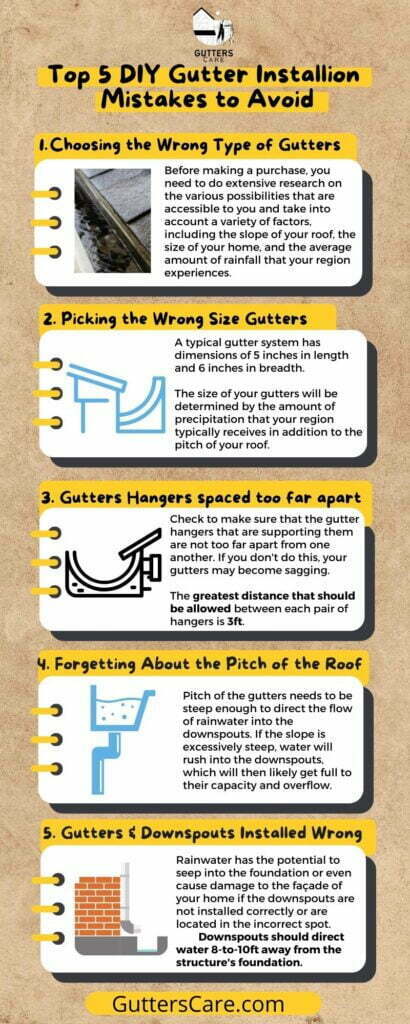
The following are some of the most typical errors that homeowners make when they attempt to install gutters on their own:
1. Selecting the Wrong Type of Gutters
This is the error that gutter installation do-it-yourselfers make most frequently. Keep in mind that no two houses are the same, and because of this, the installation of gutters cannot be done on a cookie-cutter basis because each house has its own specific requirements. Before making a purchase, you need to do extensive research on the various possibilities that are accessible to you and take into account a variety of factors, including the slope of your roof, the size of your home, and the average amount of rainfall that your region experiences.
To get you started, here is an overview of the most common varieties of gutters, categorized according to their profile or shape, as well as the material they are made of:
Gutter Profiles
Half-Round Gutters – Half-round gutters are a classic design that is frequently found on properties that have a classic architectural style. Because of the design of these gutters, they cannot be mounted directly into the fascia board. Instead, you will need to attach the hangers underneath the half-round gutters in order to complete the installation.

K-Style Gutters – K-style gutters, which are currently the most popular type of gutters in the United States, offer a variety of benefits and are one of the reasons for their popularity. They have a flat surface on one side, which simplifies the process of attaching them to the fascia board. In addition, they are capable of holding more water than other types of gutters.

Fascia Gutters – Fascia gutters, which are typically seen in western regions, can perform the function of the fascia board in homes that do not already have one.

Gutter Materials
Aluminum: Aluminum gutters are favored by many homeowners because of their low cost, resistance to corrosion, lightweight design, ease of installation, and availability in a wide range of color options. Aluminum gutters also resist rust.
View aluminum gutters on Amazon here.
Copper: Copper Gutters If you are searching for gutters that will survive for a long time, copper gutters are a good choice. The only negative is that their outstanding longevity comes with a premium price tag, although this is by far the product’s most desirable feature.
View copper gutters on Amazon here.
Steel gutters: Steel that has been galvanized has had a layer of zinc added to it as part of the galvanization process, which serves to protect the steel from rust. However, when some time has passed, the zinc coating will wear away, leaving your gutters exposed to the risk of corrosion. For this reason, galvanized steel gutters require regular maintenance in order to function properly.
Gutter guards prevent leaves and other types of debris from entering your gutters and, as a result, causing them to become clogged. If your gutters are made of galvanized steel, most professionals would advise you to install gutter guards.
View steel gutters on Amazon here.
Galvalume gutters: Galvalume is a type of coated steel that has a lifespan that is about nine times longer than galvanized steel. The coating on galvalume steel is composed of zinc and aluminum.
View galvalume gutters on Amazon here.
Zinc gutters: Zinc gutters are more expensive than gutters made of aluminum, but they can last twice as long and require almost any maintenance during that time.
View zinc gutters on Amazon here.
Vinyl Gutters: Vinyl Although vinyl is not as long-lasting as metal, it more than makes up for its lack of longevity in terms of the convenience with which it can be installed and the low cost at which it can be purchased.
However, due to the fact that vinyl becomes brittle when exposed to freezing temperatures, this material might not be the greatest option for gutters on houses located in colder areas.
View vinyl gutters on Amazon here.
Buying Tip: Look for Seamless Gutters
It is recommended to use seamless gutters rather than segmented gutters. The seams of a gutter system are its most vulnerable points. It’s possible that over time, individual portions of a gutter will move apart from one another, creating a gap in the joints where the sections meet.
As a result, the likelihood that there will be a leak will increase. In addition, debris of various kinds, such as leaves and twigs, can become lodged in these joints. Seamless gutters feature fewer joints than traditional gutters, which means they require less maintenance and are less prone to leak as a result.
2. Making the Incorrect Selection for the Gutter Size
Another error that is frequently made is selecting the incorrect gutter size. A typical gutter system has dimensions of 5 inches in length and 6 inches in breadth. Its downspouts have dimensions of either 2 x 3 inches or 3 x 4 inches in length and width, and their diameters are either 3 or 4 inches.
However, in the end, the size of your gutters will be determined by the amount of precipitation that your region typically receives in addition to the pitch of your roof. If you want to collect as much rainfall as possible on your roof, you should make the pitch of your roof as steep as possible, and your gutters should be as large as possible.
Take into consideration the weather patterns of your region.
You need to take into account the potential for snowfall and ice accumulation in addition to the quantity of precipitation that your region typically receives as rain. For instance, ice dams are a very typical issue in regions that experience freezing winters. Ice dams are most commonly caused by snow that accumulates on a roof, melts, and then refreezes at the roof’s edge after being exposed to warmer temperatures. This is often the result of inadequate insulation and ventilation in the attic. If the water that is overflowing from your gutters freezes, this can also cause ice dams to form.
Naturally, ensuring that your home has sufficient insulation and that your gutters are of an acceptable size is the best approach to avoid ice dams from forming, but heated gutter systems can also be helpful in this regard. It is possible to reduce the likelihood of ice jams and overflowing gutters by installing gutter heating systems, which melt snow and ice before it reaches your gutters.
3. Hangers for the gutters are spaced too far apart
When you are installing your gutters, you need to check to make sure that the gutter hangers that are supporting them are not too far apart from one another. If you don’t do this, your gutters may become sagging.
The greatest distance that should be allowed between each pair of hangers is three feet. This is the general rule that should be followed. However, the gutter hangers on houses that are located in colder regions should be no more than two feet away from one another. This is because greater support is required to counteract the additional weight that is caused by snow and ice.
4. Failing to Take Into Account the Pitch of the Roof
The pitch of the gutters needs to be steep enough to direct the flow of rainwater into the downspouts. If the slope is excessively steep, water will rush into the downspouts, which will then likely get full to their capacity and overflow.
On the other hand, if the angle is too low, water will pool in some portions of the gutter. This can be avoided by increasing the angle. When installing your gutter system, a gutter contractor with experience will take into consideration the variables listed above.
5. An improper installation of the gutters and downspouts
It is important not to overlook the downspouts. Rainwater has the potential to seep into the foundation or even cause damage to the façade of your home if the downspouts are not installed correctly or are located in the incorrect spot. In an ideal situation, your home’s downspouts should direct water eight to ten feet away from the structure’s foundation.
Patio Coverings to Prevent Water Damage
Rainwater is directed away from your roof and prevented from seeping into your foundation thanks to gutters, which are responsible for this function.
Awnings are a great option to consider if you want to keep the rain off of your patio and the furniture you keep out there. Awnings that can be retracted inside the building are a particularly good option. Retractable awnings make it simple to tailor the amount of shade or sunlight that falls on your patio to your specific preferences.
Why it is Best to Have Professionals Install Gutters Instead of Attempting It Yourself
The majority of homeowners opt to perform their own gutter repairs and gutter maintenance in order to save money on labor costs; however, they are often unaware that this strategy could end up costing them more money in the long term.
Keep in mind that the gutters on your roof are the very first line of defense against rain. As a result, any installation mistake, which is possible in a do-it-yourself project given the complexity of gutter installation, might leave your roof susceptible to damage caused by moisture. Any savings you might make on labor expenses will be soon eaten up by the costs of repairs and replacements over the course of the project’s lifetime.
It is much more prudent to put the needs you have into the care of professionals that specialize in the installation of gutters and retractable awnings. You will be able to have peace of mind knowing that your gutter was installed correctly and that it is protecting your roof in this way. You won’t only be safe from falls, but you’ll also save a lot of time and energy in the process.
Before deciding to hire a contractor, you should be sure to conduct adequate research.
